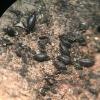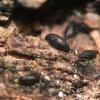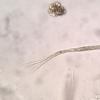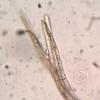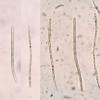
16-03-2012 17:19
Bonjour, l'été dernier j'ai trouvé un pezize su

13-03-2012 21:58
Daniel GhyselinckBonsoir,Afin de faire avancer l'inventaire de ma r

14-03-2012 00:23
 Björn Wergen
Björn Wergen
Hi all,I am looking around for literature about th

12-03-2012 00:26
Ridha EL MOKNIHello Dear mushroom experts, yesterday I found thi

11-03-2012 12:48
 Chris Yeates
Chris Yeates
I have collected good material of an Echinosphaeri

11-03-2012 12:06
bonjour j'ai trouvé cet asco sur une barriere con
Mytilinidion ?
Ethan Crenson,
11-03-2020 22:18
Hello all,
A friend found these last weekend in New York City. They are tiny, less then 1mm in length, mussel-shell-like fruiting bodies on well rotted conifer. They seem to turn the substrate somewhat black. The asci are cylindrical, 142-163 x 6.2-7.5µm. The spores are hyaline to very light brown/yellow, very elongated, 4-7 septate, 57-72 x 2-3µm. Based on the number of septa it seems like it should be M. scolecosporum. But the spores are somewhat too long. Based on spore length it would fit better with M. australe, but is short on septa for that species. (I am using Boehm's key)
Any ideas?
Thank you,
Ethan
Alain GARDIENNET,
11-03-2020 22:55
Re : Mytilinidion ?
Hi Ethan,
Again an amazing fungus ! Mytilinidion cf. scolecosporum indeed, but not australe, septa lacking.
Alain
Ethan Crenson,
11-03-2020 23:07
Re : Mytilinidion ?
Alain, thank you for your quick reply! Do you also find M. scolecosporum with spores that are longer than what is given in Boehm's key? On the other hand I find Oedohysterium sinense with spores that never approach the outer limit for spore length given in the key, but rather cluster in the bottom 1/3 for length. I wonder if there are simply regional variations.
On another note, I sent the other hysterioid (on Rosaceae) to you in the mail this morning.
Again, thanks! You are right, it is an amazing fungus.
Alain GARDIENNET,
11-03-2020 23:24
Re : Mytilinidion ?
I envy you finding those fungi I like so much. I don't think I found a true Mytilinidion scolecosporum. In 2007 I took my first steps in mycology and now with more experience I have doubts about this collection (maybe a Lophium mytilininum with broken spores). I have never found any scolecosporate Mytilinidion. However, I think that given the size of the spores, variations such as the ones you observe are not impossible. In this family the septation of the spores is a more reliable feature.
Alain


